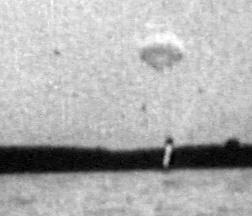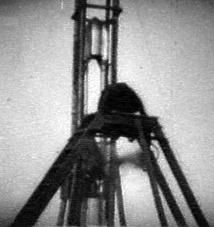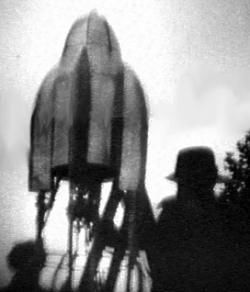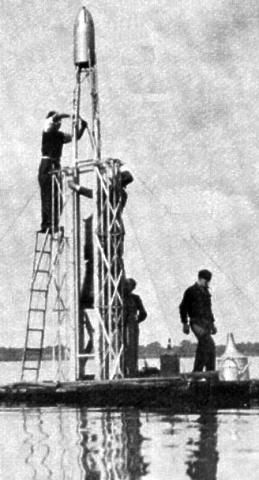
Home - Search - Browse - Alphabetic Index: 0- 1- 2- 3- 4- 5- 6- 7- 8- 9
A- B- C- D- E- F- G- H- I- J- K- L- M- N- O- P- Q- R- S- T- U- V- W- X- Y- Z
Magdeburg
 Nebel Credit: © Mark Wade |
Status: Retired 1933. First Launch: 1933-06-29. Last Launch: 1933-09-18. Number: 8 . Thrust: 1.96 kN (441 lbf). Height: 4.60 m (15.00 ft).
Mengering, an engineer working for the city of Magdeburg, was entranced by the theories of Peter Bender, who proposed that the people of the earth are in fact living on the inside surface of a hollow sphere. Mengering believes that this could be proven by firing a rocket vertically from Magdeburg. If Bender was right, the rocket should impact south of New Zealand. Mengering convinced the city authorities to fund experiments leading to this objective.
Rudolf Nebel, a founding father of the Germany VfR rocketry research society, sees an opportunity. Nebel was now a member of the Nazi Party. In December 1932 he used his contacts to obtain a contract from Magdeburg for 25,000 Marks to finance the first step. He was to build a rocket that would carry a man to an altitude of one kilometer, from where the pilot will bail out and return to earth by parachute. The rocket was to be fired on 11 June 1933 in a huge event publicizing the city. The Pilot Rocket would be in the form of the existing VfR Mirak Repulsors, with the passenger in a bullet-shaped fairing below the engine compartment, and the propellants being stored in two long cylindrical tanks trailing the engine. It was to be 7.6 m tall and powered by an engine of 600 kgf. A prototype was to be built first, 4.6 m tall, powered by a 200 kgf motor. This would not be capable of carrying a pilot, but would have a parachute for recovery.
A test stand was completed for ground test of rocket engines of up to 1000 kgf. Tests of the 200 kgf motor begin on 22 March 1933. Motors explode on 25 March and 3 April, but by the end of April, 20 test runs had been conducted and the motor was considered reliable enough for flight test (despite several burn-throughs of the throat).
The first attempt to launch the subscale prototype of the Magdeburg Pilot Rocket was made on 9 June 1933. A launch stand 9 m tall was erected in the countryside near Magdeburg. However the rocket developed insufficient thrust to clear the tower. Other attempts on 10 and 11 June were also unsuccessful, due to leaky valves and other quality problems. The rocket was returned to the shop for rework.
On 29 June 1933 the 200 kgf prototype rocket was finally launched. However it caught on one of the rails in the launch tower and was flung horizontally as it cleared the tower. It flew 300 m horizontally over the pastures, then slid along the ground for 10 m more. It was relatively intact, but the Magdeburg city officials were not interested in funding further attempts. Nebel received only 3200 Marks for his work.
Nebel continued his efforts. The Magdeburg prototype rocket was reworked into a four-stick design and flown from Lindwerder Island at Tegeler Lake near Berlin in July 1933. It reached 1000 m, looped a few times, then thrust straight toward the earth. The parachute deployed at the last moment and the rocket splashed down in the lake 100 m from the launch stand. Further launches were made from Tegeler and Schielow lakes through September, 1933, but finally the money ran out and the new Nazi government prohibited further private rocket research.
While Nebel's efforts were belittled by his fellow German engineers, he did manage to fly the largest rockets in Germany until the unsuccessful launches of the A3 in 1937.
People: Nebel. Country: Germany. Bibliography: 47.
 | Magdeburg Rocket Credit: © Mark Wade |
 | Magdeburg Credit: © Mark Wade |
 | Magdeburg |
 | Magdeburg Sea Sunk |
 | Magdeburg Sea Launch |
 | Magdeburg Sea Launch |
 | Magdeburg Sea Launch |
 | Zmagdel |
 | Magdeburg Sea Launch |
 | Magdeburg Launch Pre |
 | Zmagdw |
 | Magdeburg Sea Launch |
 | Magdeburg |
 | Magdeburg Recovery |
 | Magdeburg Sea Launch |
 | Magdeburg Tower Laun |
 | Magdeburg Tower Laun |
 | Magdeburg |
 | Magdeburg |
 | Nebel Rocket |
1932 December 18 - . Launch Vehicle: Magdeburg.
- Magdeburg Project - .
Nation: Germany.
Related Persons: Nebel.
Mengering, an engineer working for the city of Magdeburg, is entranced by the theories of Peter Bender, who proposes that the people of the earth are in fact living on the inside surface of a hollow sphere. He believes that this can be proven. A rocket fired vertically from Magdeburg should impact south of New Zealand. Mengering convinces the city authorities to fund experiments leading to this objective. Nebel, now a member of the Nazi Party, obtains a contract of 25,000 Marks for the first step. He will build a rocket that will carry a man to an altitude of one kilometre, from where the pilot will bail out and return to earth by parachute. The rocket is to be fired on 11 June 1933 in a huge event publicizing the city. The Pilot Rocket would be in the form of the VfR Repulsors, with the passenger in a bullet-shaped fairing over the engine compartment, and the propellants being stored in two long cylindrical tanks trailing the engine. It was to be 7.6 m tall and powered by an engine of 600 kgf. A prototype was to be built first, 4.6 m tall, powered by a 200 kgf motor. This would not be capable of carrying a pilot, but would have a parachute for recovery.
1933 March 22 - . Launch Vehicle: Magdeburg.
- Magdeburg Project tests - .
Nation: Germany.
A test stand is completed for ground test of rocket engines of up to 1000 kgf. Tests of the 200 kgf motor begin on 22 March. Motors explode on 25 March and 3 April, but by the end of April, 20 test runs have been conducted and the motor is considered reliable enough for flight test (despite several burn-throughs of the throat).
1933 June 9 - . Launch Vehicle: Magdeburg.
- Magdeburg launch attempt - .
Nation: Germany.
First attempt to launch the subscale prototype of the Magdeburg Pilot Rocket. A launch stand 9 m tall is erected in the countryside near Magdeburg. However the rocket develops insufficient thrust to clear the tower. Other attempts on 10 and 11 June are also unsuccessful, due to leaky valves and other quality problems. The rocket is returned to the shop for rework.
1933 June 29 - . Launch Site: Magdeburg. Launch Vehicle: Magdeburg.
- Magdeburg launch - .
Nation: Germany.
Apogee: 0.0100 km (0.0062 mi). Range: 0.31 km (0.19 mi).
The 200 kgf prototype rocket is finally launched. However it catches on one of the rails in the launch tower and is flung horizontally as it clears the tower. It flies 300 m horizontally over the pastures, then slides along the ground for 10 m more. It is relatively intact, but the Magdeburg city officials are not interested in funding further attempts. Nebel receives only 3200 Marks for his work.
Early July 1933 - . Launch Site: Magdeburg. Launch Vehicle: Magdeburg.
- Nebel rocket - .
Nation: Germany.
Apogee: 1.00 km (0.60 mi). Range: 0.10 km (0.06 mi).
The Magdeburg prototype rocket is reworked into a four-stick design and flown from Lindwerder Island at Tegeler Lake near Berlin. It reaches 1000 m, loops a few times, then thrusts straight toward the earth. The parachute deploys at the last moment and the rocket splashes down in the lake 100 m from the launch stand. It is recovered.
1933 July 21 - . Launch Site: Magdeburg. Launch Vehicle: Magdeburg.
- Nebel rocket - . Nation: Germany. Apogee: 0.0060 km (0.0037 mi). After an aborted launch, the rocket does clear the tower but on oxidiser valve fails to open. The rocket reaches only 60 m but splashes down in the lake and is recovered..
1933 August 3 - . Launch Site: Schwielow Lake. Launch Vehicle: Magdeburg.
- Nebel rocket - . Nation: Germany. Apogee: 0.0010 km (0.0006 mi). After objections by the owner of the previous launch location, tests are moved to Schwielow Lake, with launch from the stand erected on a motor boat. The rocket explodes soon after lift-off..
1933 August 11 - . Launch Site: Schwielow Lake. Launch Vehicle: Magdeburg.
- Nebel rocket - . Nation: Germany. Apogee: 0.0020 km (0.0012 mi). Second attempt from Schwielow Lake. The rocket goes horizontal and hits the water in the lake's steamboat channel. It cannot be recovered..
1933 August 31 - . Launch Site: Schwielow Lake. Launch Vehicle: Magdeburg.
- Nebel rocket - . Nation: Germany. Apogee: 2.00 km (1.20 mi). Third launch from Schwielow Lake. Rocket flies out of sight and is not found..
1933 September 9 - . Launch Site: Schwielow Lake. Launch Vehicle: Magdeburg.
- Nebel rocket - . Nation: Germany. Apogee: 0.10 km (0.06 mi). Fourth launch from Schwielow Lake. This employs a new design with two longer tanks in place of four shorter propellant tanks. Results 'poor'..
1933 September 18 - . Launch Site: Schwielow Lake. Launch Vehicle: Magdeburg.
- Nebel rocket - . Nation: Germany. Apogee: 0.10 km (0.06 mi). Final launch from Schwielow Lake using the new design. Results again 'poor'..
Back to top of page
Home - Search - Browse - Alphabetic Index: 0- 1- 2- 3- 4- 5- 6- 7- 8- 9
A- B- C- D- E- F- G- H- I- J- K- L- M- N- O- P- Q- R- S- T- U- V- W- X- Y- Z
© 1997-2019 Mark Wade - Contact
© / Conditions for Use